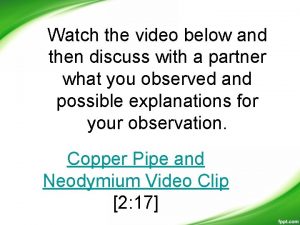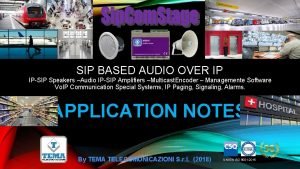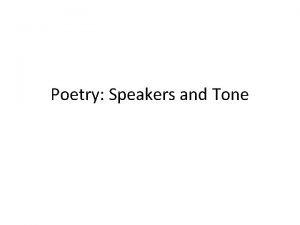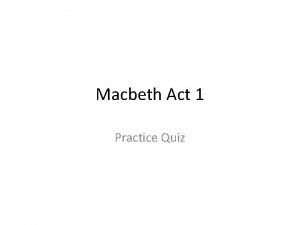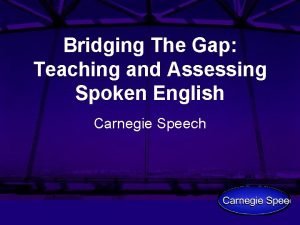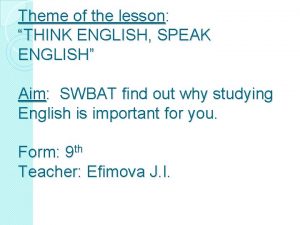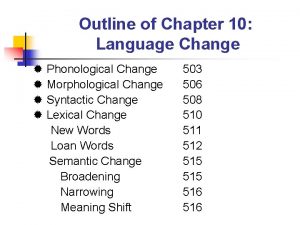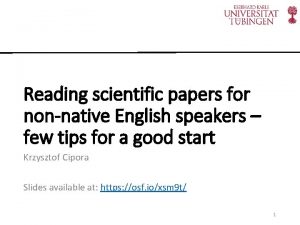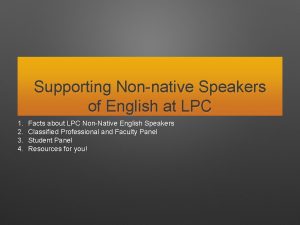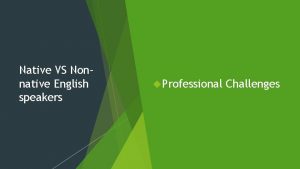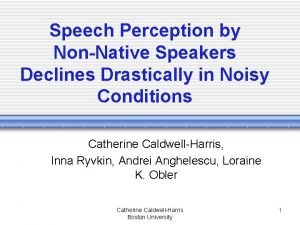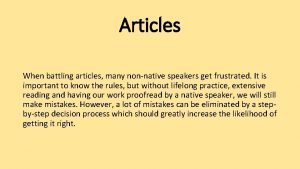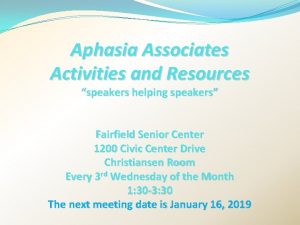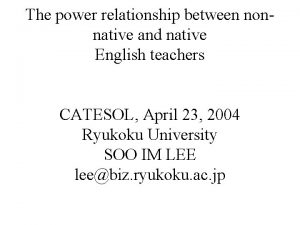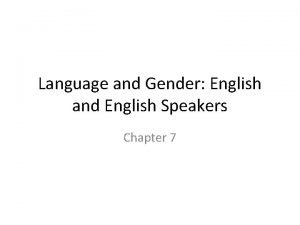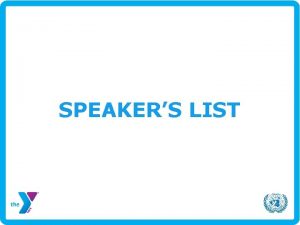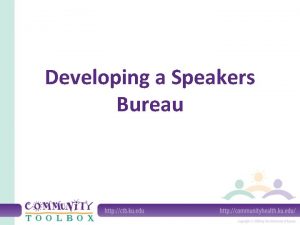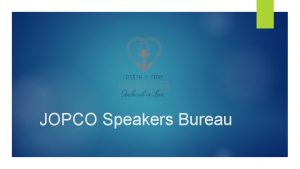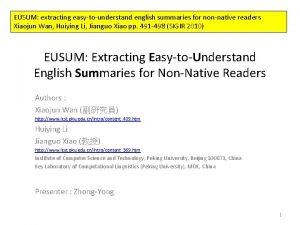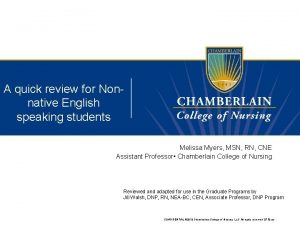What Why and How 15 NONNATIVE ENGLISH SPEAKERS
























- Slides: 24

What, Why, and How? 15 NON-NATIVE ENGLISH SPEAKERS Definition and rationale English survey Parts of speech self-review Top 8 tips to improve your reading Tips for addressing length in academic writing Turning spoken English into written Tips for reported speech Turning questions into statements Conveying an author’s point of view Agreeing and disagreeing with an author Proofreading tips for ESOL students

WHO ARE NON-NATIVE SPEAKERS? Used in the context of living in the United States, the term non-native speakers means Students who are not native speakers of English, meaning that English is not their first language. Other common terms used are ESL (English as a Second Language) and ESOL (English Speakers of Other Languages). WHY HAVE A SEPARATE CHAPTER FOR NON-NATIVE SPEAKERS? Non-native speakers in mainstream college classes face the extra challenge of reading, speaking, and writing in a language they have not studied their whole lives. The ESOL Instructors at Skyline College have designed this chapter to help provide added assistance to those students in mainstream English classes to support their learning and success. HOW CAN I IMPROVE MY SUCCESS? If you are enrolled in a mainstream English class (a class that is not ESOL specific so contains a mixture of native and non-native English speakers), then most likely there will be no class time dedicated to ESOL specific needs and issues. To ensure your success in the class and in improving your English skills, you will want to take advantage of your resources. The Learning Center in building 5 has a staff of dedicated English tutors (faculty, grad students and peer tutors) and ESOL trained tutors as well. You can enroll in a credit/no-credit lab course and earn college credit while getting assistance from tutors and taking advantage of the other resources in The Learning Center. Additionally, you can use the materials in this chapter as well as the Grammar and Style chapters in this Rhetoric to strengthen your skills.

English Survey To begin, you can complete this survey and then take it with you when you first meet with your English teacher so you can go over your history, your goals for the class, and your particular needs as a student. This will allow your English teacher to get to know you better, and you can make a plan together to help you be successful in the class. (1) What is your native language? Can you speak, read and write fluently in this language? What other languages do you know? Can you speak, read, and write in each? (2) How long have you lived in the United States? When did you begin studying English? How many English classes have you taken? What grade level? What grades did you get in those classes? (3) What areas in grammar do you find most challenging? What have past teachers commented on about your writing? (4) What other skill areas do you want to strengthen? Reading comprehension? Organizing your ideas? Developing your ideas? Doing research? Listening? Class discussion? (5) Circle the answers to the following questions about your editing/proofreading habits: I edit and proofread the final draft of writing assignments. Always Often Rarely Never Somebody else helps me with editing and proofreading my papers. Always Often Rarely Never I edit and proofread by listening to how my writing “sounds. ” Always Often Rarely Never I analyze my sentence structure by circling subjects and underlining verbs.

PRACTICE Parts of Speech Self-Review Be sure you understand the foundational elements of English. For any of the following you are not sure of or cannot define, use this as a guide for which topics you should review in the Chapter 14: Grammar. Noun Pronoun Definition: _________________________ Examples: ____________ Verb Preposition Definition: _________________________ Examples: ____________ Adjective coordinator) Conjunction (also known as Definition: _________________________ Examples: ____________ Adverb Definition: _____________ Examples: _____________ (Pause)

ANSWERS Parts of Speech Self-Review Noun Definition: a word (other than a pronoun) used to identify any of a class of people, places, or things common noun, or to name a particular one of these proper noun. Examples: chair, dog, essay, left-handed people Verb Definition: a word used to describe an action, state, or occurrence, and forming the main part of the predicate of a sentence, such as hear, become, happen. Examples: run, was singing, will be calling, sank Adjective Definition: a word or phrase naming an attribute, added to or grammatically related to a noun to modify or describe it. Examples: red, scary, enormous, challenging Adverb Definition: a word or phrase that modifies or qualifies an adjective, verb, or other adverb or a word group, expressing a relation of place, time, circumstance, Pronoun Definition: a word that can function by itself as a noun phrase and that refers either to the participants in the discourse (e. g. , I, you ) or to someone or something mentioned elsewhere in the discourse (e. g. , she, it, this). Examples: he, they, we Preposition Definition: a word governing, and usually preceding, a noun or pronoun and expressing a relation to another word or element in the clause, as in “the man on the platform” and “she arrived after dinner. ” Examples: around, on, under, above Conjunction (also known as coordinator) Definition: a word used to connect clauses or sentences or to coordinate words in the same clause. Examples: For, And, Nor, But, Or, Yet, So (FANBOYS)

Top Eight Tips to Improve Your Reading: (1) Read as much as possible: the more you read, the more you build up your vocabulary and sentence structure. Choose books that interest you and are more fun than watching television. (2) Develop a system for vocabulary. Keep a list of vocabulary words with their definitions to review again and again. (3) Make friends with a high-quality dictionary. Develop a system for finding key words and use the dictionary to find definitions for key words. (4) Make enemies with your dictionary. Don’t overuse your dictionary or interrupt your reading by looking up every word. Studies show that breaks in reading mean a gap in your understanding. (5) Be familiar with academic word lists. Find a vocabulary review book and use it to build your vocabulary. The more vocabulary you know, the better you will understand what you read. (6) Annotate your academic reading. Underline important points and make notes in the margin. Turn the text into a conversation! If you want to sell your book back, use post-it notes for your comments.

What Researchers Say about Vocabulary and Reading What does this research mean? It means that for advanced levels of ESOL, you need to nail down the 2, 700 frequent core words and be well into learning the 6, 000 core words! * 90% comprehension is not good enough! That means you will not understand 1/10 words. You need stronger vocabulary than that if you want to understand a newspaper or pop fiction (such as a mystery novel). **95% is enough to guess the meaning of the words you don’t know.

Tips for Addressing Length in Academic writing should be developed into powerful sentences that convey an idea completely. One common problem among second-language speakers is when students don’t observe punctuation rules; the sentences end up Writing: too long because they are not well punctuated, and the instructor tells the student, “Make your sentences shorter and simpler. ” However, another problem is created here because short and simple sentences are not as powerful as longer, more descriptive sentences. So what can you do? What is the idea that you want to convey? It may be several ideas that are connected. Separate them out first. Example: Source: “The Black Table is Still There” by Lawrence Otis Graham is surprised to see that racial self-separation still exists at his old high school. Graham doesn’t know whether he should feel proud or sad about it. Final sentence: In The Black Table is Still There, Lawrence Otis Graham is surprised to see that racial selfseparation still exists at his old high school, but he isn’t sure whether he should feel proud or sad about it. State your ideas in simple clear sentences first. Use powerful verbs, nouns, and strong, descriptive adjectives. After your sentences convey those ideas, then consider joining them together using sentence joining strategies and tools such as FANBOYS (coordination) or subordination. Practice for Addressing Length in Academic Writing Using a source from your current course of study, select an idea that you wish to convey. Break it into several ideas and state them in their own clear sentences first. Use powerful verbs, nouns, and strong, descriptive adjectives. Finally, join the ideas into one powerful idea. Refer to rules you know that address sentence joining (such as FANBOYS and subordination). Source: _____________________________________ Idea 1: _____________________________________ Idea 2: _____________________________________ Idea 3: _____________________________________ Final sentence: __________________________________

Turning Spoken English into Spoken English and written English differ in many important ways. One way they differ is in how questions are interpreted in past. Written: time. For example, look at this conversation between a teacher and a student: Student: Teacher: Did you receive my email? When did you send it? Yesterday. I’m sorry, I didn’t see it. What was your question? I want to know if the research paper is due next week. Yes, it is. Now, look at the description of the same conversation, but written instead of spoken. I saw my teacher and asked her if she had received my email, which I had sent the day before. She hadn’t seen it, so she asked what my question was. I asked her whether the research paper was due next week, and she said it was. There are three important differences between spoken English and written English: (1) Length. Written English often takes more words to convey the same idea that can be conveyed in spoken English. The conversation above took 36 words, but the written version took 47 words. (2) Reported speech. In the written version that describes the spoken conversation, the verbs shift from present to past, and from past to past perfect. This is because the speaker is reporting something that already happened. (3) Using if/whether to turn a question into a statement. In reported speech, the question cannot remain a question. It must be turned into a statement. Incorrect: I asked her did she receive my email. Correct: I asked her if she received my email. Incorrect: I asked her is the research paper due next week. Correct: I asked her whether the research paper was due next week.

When should I use it? Tips for Reported speech: Reported speech should only be used when reporting an action in past time. It is often used in the reporting fields of journalism and news casting, but may be appropriate for some forms of academic writing where reporting of a source is needed. Example: Event: A fire in a building, set by arsonists Police statement: We believe the fire was set by juveniles. The juveniles were seen by neighbors earlier in the day. Journalist: “The police said that the fire had been set by juveniles who had been seen loitering around the building earlier in that day. ” Reported speech is NOT used when discussing the words of an author of fiction or non-fiction (the present tense is used). When Mark Twain states “The funniest things are the forbidden, ” he reminds us how we revel in pushing the boundaries of society’s rules. Perhaps he also suggests that he himself has been taken to task by those rules, and he seeks safety in like-minded individuals who appreciate risk. Reported speech is also NOT used when reporting research that has been published and is used for determining other research (present tense is used). According to De. Francis (1989), the Chinese writing system is a syllabic system of writing. How do I use it? Take the verb from the original tense and move it backwards in time.

PRACTICE Practice for Reported Speech Imagine that all of the following statements are source material for your paper. Decide whether these statements should be moved into reported speech. If they should be moved into reported speech, do so. If not, write “not reported speech” in the blank. (1) College President, Memo to College Governance Council: We are ready and willing to support the veterans who have served our country by providing them with excellent opportunities for success. ______________________________________ (2) Author, Paolo Freire, “Pedagogy of the Oppressed”: Self-depreciation is another characteristic of the oppressed, which derives from their internalization of the opinion the oppressors hold of them. ______________________________________ (3) Health and Human Services Secretary, Kathleen Sebelius: I believe strongly in the need for accountability, and in the importance of being good stewards of taxpayer dollars. ______________________________________ (4) Linguists Edelsky and Goodman: It is more common in modern education to combine the writing process with whole language to form a holistic process and philosophy of literacy learning. ______________________________________ (Pause)

ANSWERS Practice for Reported Speech Imagine that all of the following statements are source material for your paper. Decide whether these statements should be moved into reported speech. If they should be moved into reported speech, do so. If not, write “not reported speech” in the blank. (1) College President, Memo to College Governance Council: We are ready and willing to support the veterans who have served our country by providing them with excellent opportunities for success. The College President wrote to the College Governance Council that they were ready and willing to support the veterans who have served our country by providing them with excellent opportunities for success. (2) Author, Paolo Freire, “Pedagogy of the Oppressed”: Self-depreciation is another characteristic of the oppressed, which derives from their internalization of the opinion the oppressors hold of them. Not reported speech (3) Health and Human Services Secretary, Kathleen Sebelius: I believe strongly in the need for accountability, and in the importance of being good stewards of taxpayer dollars. Kathleen Sebelius, the Secretary for Health and Human Services stated that she believes strongly in the need for accountability, and in the importance of being good stewards of taxpayer dollars. (4) Linguists Edelsky and Goodman: It is more common in modern education to combine the writing process with whole language to form a holistic process and philosophy of literacy learning. Not reported speech

PRACTICE Practice for Reported Speech Now, find two sources for a paper that you are writing. Choose one that will be appropriate for converting into reported speech, and one that will remain in present tense. Remember to cite your source. 1. 2.

Using If and Whether to Turn Yes/No Questions into When using reported speech, Yes/No questions cannot remain in question format. It is necessary to Statements: re-word the question to put it into statement format. Remember the earlier example: Incorrect: I asked her did she receive my email. Correct: I asked her if she received my email. Incorrect: I asked her is the research paper due next week. Correct: I asked her whether the research paper was due next week. Notice the many ways that a question can be worded.

PRACTICE Practice for Reported Speech Convert these questions into statements. Note the many ways to state a Yes/No question. Example: Scholarship committee question: Will giving laptops to students improve student success? Statement: The scholarship committee is curious to know whether giving laptops to students will improve student success. 1. Community question: Will the cost associated with the earthquake cause local taxes to go up? Statement: __________________________________ 2. Researcher question: Is the low number of enrollees in the new program connected to the scandal involving the program’s director? Statement: (Pause)

ANSWERS Practice for Reported Speech Convert these questions into statements. Note the many ways to state a Yes/No question. Example: Scholarship committee question: Will giving laptops to students improve student success? Statement: The scholarship committee is curious to know whether giving laptops to students will improve student success. 1. Community question: Will the cost associated with the earthquake cause local taxes to go up? Statement: The community would like to know if the cost associated with the earthquake will cause local taxes to go up. 2. Researcher question: Is the low number of enrollees in the new program connected to the scandal involving the program’s director?

Conveying an Author’s Point of Part of academic writing is accurately conveying the viewpoint of writers. You want to clearly View: state their points of view and arguments before you add your own evaluation and analysis. In other words, you want to fairly and accurately present the ideas in the material you are offering a critique of. Here is an example of conveying an author’s point of view: In his essay, “We Should Cherish Our Children’s Freedom to think, ” author Kie Ho states that the U. S. is the “country of innovation” because of its emphasis on free thinking. He argues that countries who value conformity over freedom of thought are at a disadvantage in the global marketplace.

Conveying an Author’s Point of View:

Agreeing and Disagreeing with an Author’s Point of View: In many cultures, it is considered rude or unwise to disagree with a published author. However, in the United States, it is considered perfectly appropriate for a student writer to agree or disagree with a professional author. In fact, it shows the student writer’s ability to think critically and be a participant in intellectual dialogue. Your professor wants to see that you can think independently and can critique another writer’s ideas. When you are able to critique an author, you show yourself to be a strong thinker and writer. There are many words and phrases that you can use to agree or disagree with an author, as you will see below. Examples of Showing Agreement with an Author: Brady proclaims that she wants a wife to support her and take care of all the child-rearing and homemaking duties so that she can be free to pursue a life without entanglements. It is easy to agree with her irony and obvious anger at having little choice in strict gender roles. Mc. Cuistion may be correct in that kids have to “fit themselves into categories imposed by society” (283); after all, if society imposes these rules, what choice do young people have but to follow them? Perrin’s argument is convincing because no one can doubt his maleness after his explanation of his job (a horse wrangler), yet the reader sees how little freedom society allows him to be who he is. Examples of Showing Partial, or Full, Disagreement with an Author: While Brady’s anger is understandable, her hyperbole is not completely convincing; she assumes that the whole purpose of marriage is to deliberately take advantage of the wife, and that the wife is, by definition, a servant. This is an antiquated view (the piece was written in the seventies) and therefore may not be representative of most marriages. I hesitate to endorse her view of “wife=slave” because I feel she isn’t fair to men who truly uphold their half of marriage responsibilities. The argument is not effective because it focuses on one angle. What Mc. Cuistion calls “a competitive sense that reverberates throughout adult life” (283). I would call building human connections. Mc. Cuistion fails to consider that competition is part of the way that humans, not just male humans, interact all over the world. Competition teaches us social dynamics, not just “controlled violence” (283) as Mc. Cuistion insists.

Agreeing and Disagreeing with an Author’s Point of View: Notice that the language that is used is very polite and respectful, even if the student writer disagrees with the published author. Use the following words to agree and/or disagree with authors.

PRACTICE Agreeing and Disagreeing with an Author’s Point of View: (1) Locate a quotation by an author that you are reading for your class. Choose a quotation that clearly states the author’s point of view. Write that quote here: (2) Choose reporting verbs that will adequately and creatively report what the author is saying. Write those verbs here: (3) State your opinion of the author in the form of a critique. Use language for critiquing authors. Write that here. (4) Now, put it all together. Present the author’s point of view

Proofreading Tips for ESOL Students Proofreading is the process of error detection and error correction in your own work. Put in other words, it is the identification and correction of your own mistakes. It should be an integral part of your writing process.

Proofreading Checklist Directions: Go through this checklist, one item at a time. When you have checked for this item throughout the essay, mark what is true for your paper.

that concludes 15 NON-NATIVE ENGLISH SPEAKERS
 Hey hey bye bye
Hey hey bye bye Shira packer
Shira packer Don't ask why why why
Don't ask why why why Currents and magnets summarizer
Currents and magnets summarizer Contra viento y marea
Contra viento y marea Ad630 application notes
Ad630 application notes Poem speaker
Poem speaker Speakers tone examples
Speakers tone examples Marlon paz
Marlon paz Nnnn speakers
Nnnn speakers Soundblock coaxial speakers creative commons pictures
Soundblock coaxial speakers creative commons pictures Character list macbeth
Character list macbeth Dear distinguished guests
Dear distinguished guests Agora speakers
Agora speakers Speakers
Speakers Jos macau
Jos macau Hotel sound system
Hotel sound system Vansina
Vansina Spoken english and broken english g.b. shaw summary
Spoken english and broken english g.b. shaw summary Napkin british english
Napkin british english American british word differences
American british word differences The gap between written and spoken english
The gap between written and spoken english Stressed syllable motorway
Stressed syllable motorway Think in english speak in english
Think in english speak in english Tumoxan
Tumoxan



